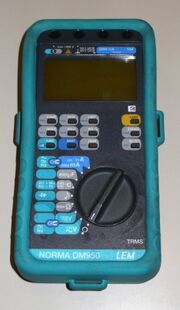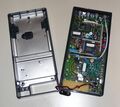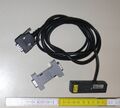Difference between revisions of "Norma DM950"
| Line 118: | Line 118: | ||
If the interface cannot be powered from RS232 (e. g. RS232-USB converter with too low voltage), switching on the multimeter with the FUNC button pressed powers the interface from multimeter. | If the interface cannot be powered from RS232 (e. g. RS232-USB converter with too low voltage), switching on the multimeter with the FUNC button pressed powers the interface from multimeter. | ||
The interface board contains a battery-buffered clock and NVRAM memory. | |||
The ''printer cable'' has got a power connector (10-16 V DC, 50 mA) to power the multimeter and the interface externally. Opening the plug on multimeter side should be avoided, if possible, because the nut on the opposite to the screw is loose beneath the rubber bumper and it can be a bit tricky to get it closed again without removing the glued bumper. | The ''printer cable'' has got a power connector (10-16 V DC, 50 mA) to power the multimeter and the interface externally. Opening the plug on multimeter side should be avoided, if possible, because the nut on the opposite to the screw is loose beneath the rubber bumper and it can be a bit tricky to get it closed again without removing the glued bumper. | ||
Revision as of 17:41, 4 October 2013
The LEM Norma DM9x0 Series of multimeters are 21000 count CAT II/CAT III hand multimeters with optional RS232 connectivity. The models differ by precision and feature set.
They were also sold as OEM devices by Siemens.
The manufacturer was a company named Norma, later LEM Norma in Austria.
Models
| Model | Siemens OEM | Precision (DC) | Backlight | RMS | TRMS | R 20 MΩ | R 200 MΩ | U AC 1 kΩ/V | I 10A | f | C |
|---|---|---|---|---|---|---|---|---|---|---|---|
| Norma DM910 | B1024 | ±(0.5% +2d) | ● | ● | |||||||
| Norma DM920 | B1025 | ±(0.5% +2d) | ● | ● | ● | ||||||
| Norma DM930 | B1026 | ±(0.3% +3d/+2d) | ● | ● | ● | ● | ● | ● | ● | ||
| Norma DM940 | B1027 | ±(0.1% +3d/+2d) | ● | ● | ● | ● | ● | ● | ● | ||
| Norma DM950 | B1028 | ±(0.06% +3d/+2d) | ● | ● | ● | ● | ● | ● | ● | ● |
The RS232 interface is optional. All models were available with or without RS232 interface, the RS232 interface was also available as an accessory.
Hardware
Multimeter
Interface
The RS232 interface consists of the following components:
- Interface board (installed inside of multimeter, based on a NEC 75P116 microcontroller)
- Printer cable 5-pin to DB9
- PC adaptor (Null modem plug with slightly unusal pinout)
The RS232 interface is designed to allow a direct connection to a serial printer or data recorder. Therefore an adaptor is required to connect it to a PC.
Comm parameters (PC): DTR on, RTS off, RTS/CTS flow control (!).
If the interface cannot be powered from RS232 (e. g. RS232-USB converter with too low voltage), switching on the multimeter with the FUNC button pressed powers the interface from multimeter.
The interface board contains a battery-buffered clock and NVRAM memory.
The printer cable has got a power connector (10-16 V DC, 50 mA) to power the multimeter and the interface externally. Opening the plug on multimeter side should be avoided, if possible, because the nut on the opposite to the screw is loose beneath the rubber bumper and it can be a bit tricky to get it closed again without removing the glued bumper.
Photos
Multimeter:
RS232 cable:
Protocol
Printer Mode
TODO
PC communication mode
TODO













